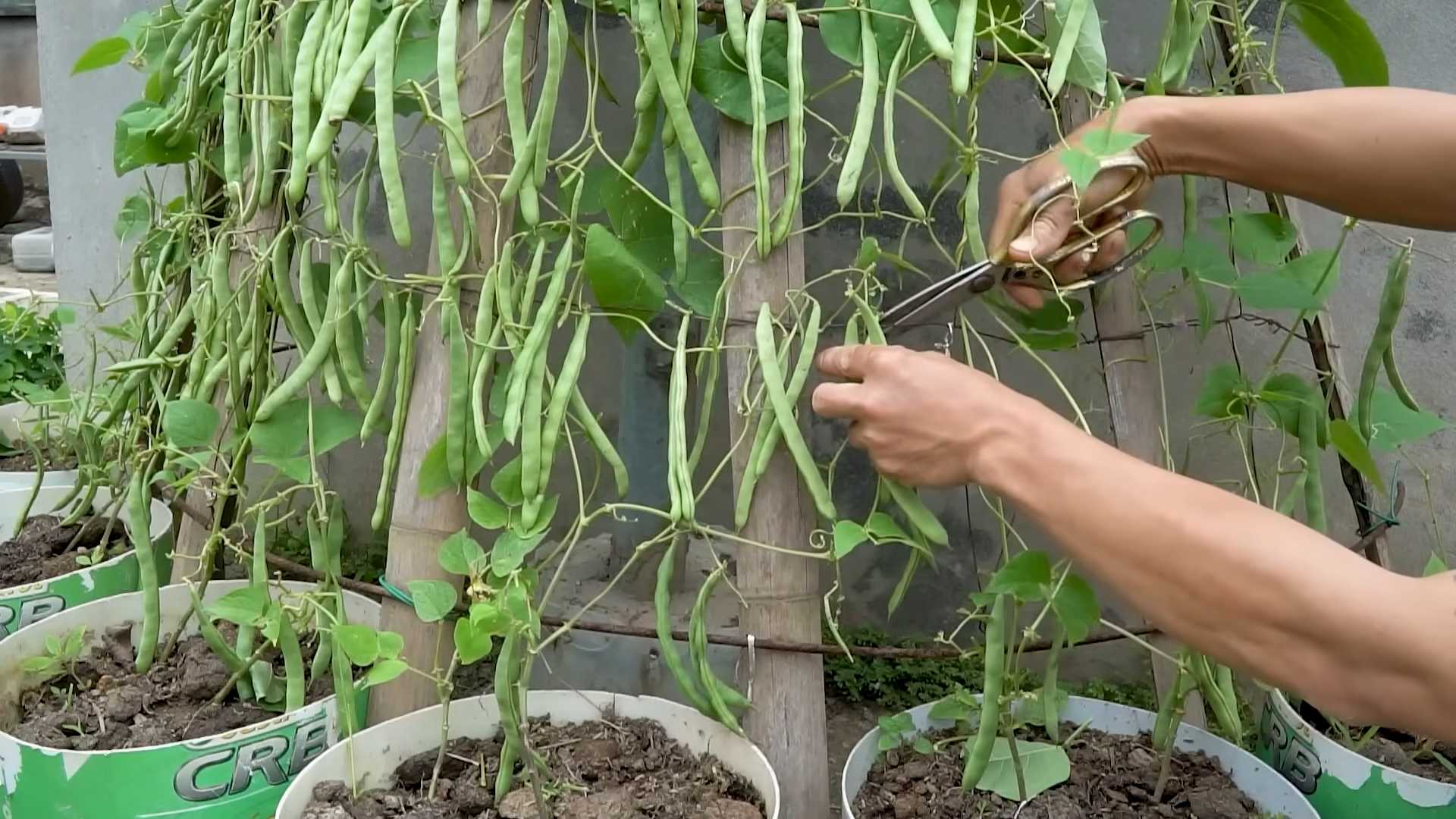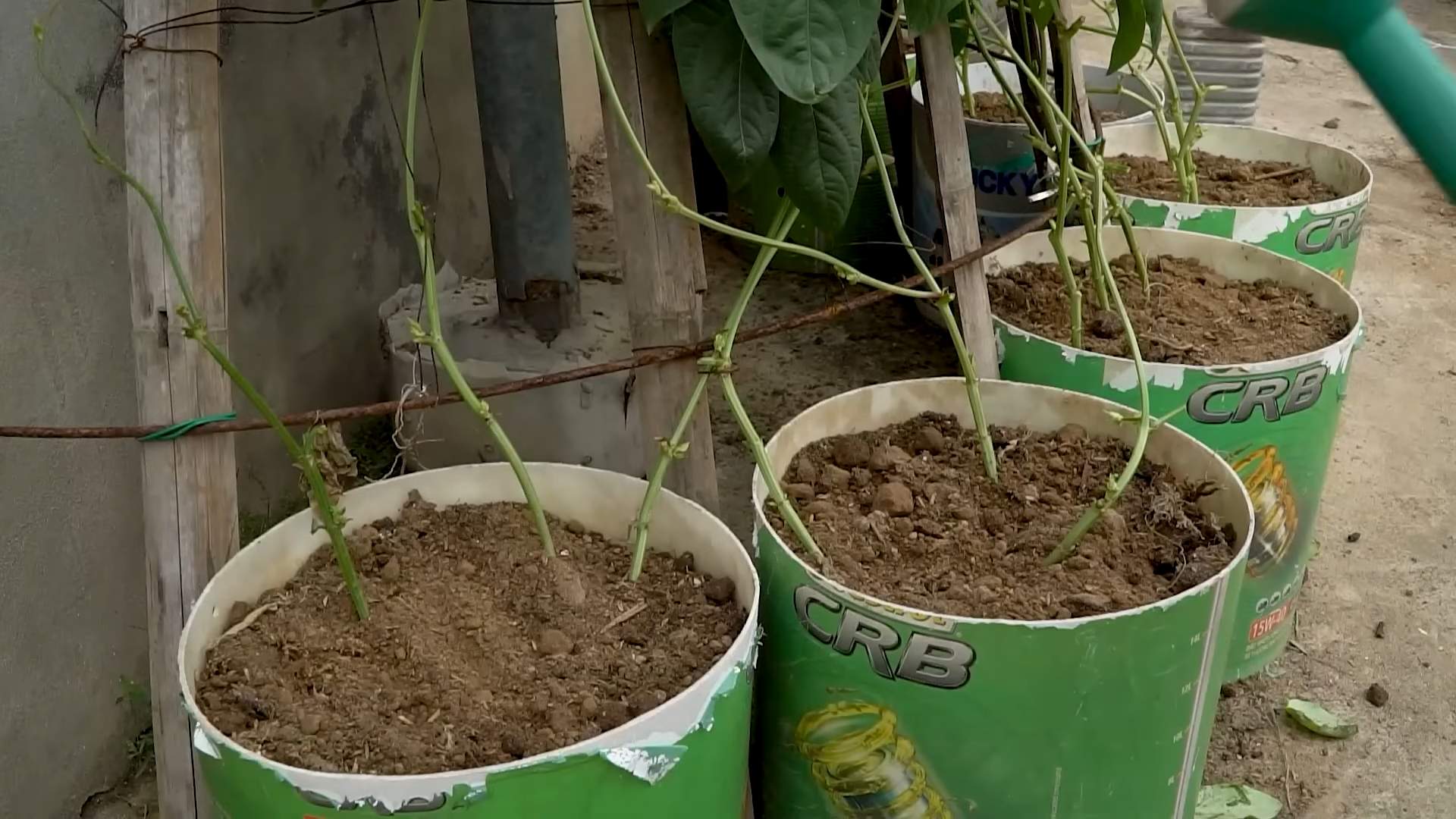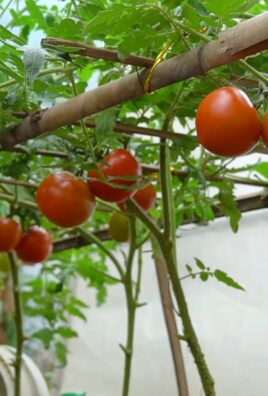Grow Long Beans Easily and watch your garden flourish with these impressive, flavorful vegetables! Have you ever dreamt of harvesting armfuls of vibrant, yard-long beans right from your own backyard? It’s more achievable than you think, and I’m here to share some simple yet effective DIY tricks that will transform your long bean growing experience.
Long beans, also known as asparagus beans or yardlong beans, have a rich history, particularly in Asian cuisine. They’ve been cultivated for centuries, adding a unique texture and taste to dishes across various cultures. Beyond their culinary appeal, growing your own long beans connects you to this heritage and offers a rewarding gardening experience.
Why should you try these DIY tricks? Well, let’s face it, sometimes growing long beans can be a bit tricky. They need the right support, proper watering, and protection from pests. But with a few clever hacks, you can overcome these challenges and enjoy a bountiful harvest. I’ve personally used these methods to grow long beans easily, even in limited spaces, and I’m excited to share my secrets with you. Get ready to roll up your sleeves and discover how to cultivate these amazing beans with confidence and ease!

Grow Long Beans Like a Pro: My Foolproof DIY Guide
Hey there, fellow gardening enthusiasts! I’m so excited to share my tried-and-true method for growing long beans – those incredibly prolific and delicious veggies that seem to stretch on forever. I’ve experimented with different techniques over the years, and this is what consistently works best for me. Get ready to harvest a bumper crop!
What You’ll Need: The Essential Supplies
Before we dive in, let’s gather everything you’ll need. Having all your materials ready will make the process smooth and enjoyable.
* Long Bean Seeds: Choose a variety that suits your climate. I personally love the ‘Yard Long’ variety, but there are many others to explore!
* Well-Draining Soil: Long beans thrive in rich, well-draining soil. You can use a good quality potting mix or amend your garden soil with compost and aged manure.
* Compost or Aged Manure: This is crucial for providing essential nutrients to your growing beans.
* Trellis or Support Structure: Long beans are climbers, so they need something to grow on. A trellis, fence, or even sturdy bamboo stakes will work.
* Gardening Gloves: Protect your hands from dirt and potential irritants.
* Hand Trowel or Garden Shovel: For digging holes and transplanting seedlings.
* Watering Can or Hose: To keep your plants hydrated.
* Optional: Seed Starting Tray and Potting Mix: If you prefer to start your seeds indoors.
* Optional: Organic Fertilizer: To boost growth and yields.
* Optional: Mulch: To retain moisture and suppress weeds.
Section 1: Starting Your Long Bean Seeds (Two Options!)
You have two main options for starting your long bean seeds: direct sowing in the garden or starting them indoors. I’ll walk you through both.
Option 1: Direct Sowing in the Garden
This is the simplest method, especially if you live in a warm climate with a long growing season.
1. Prepare the Soil: Choose a sunny spot in your garden that receives at least 6-8 hours of sunlight per day. Clear the area of weeds and debris. Loosen the soil with a garden fork or tiller to a depth of about 12 inches. Incorporate plenty of compost or aged manure into the soil to improve its fertility and drainage. I usually add a generous layer, about 2-3 inches thick, and mix it in thoroughly.
2. Sow the Seeds: Sow the seeds directly into the prepared soil, spacing them about 4-6 inches apart. Plant them about 1 inch deep. I like to plant two seeds per hole to increase the chances of germination. If both seeds sprout, you can thin them out later, keeping the strongest seedling.
3. Water Gently: Water the soil gently after sowing the seeds, being careful not to wash them away. Keep the soil consistently moist but not waterlogged.
4. Install the Trellis: This is important to do early, so you don’t disturb the plants later. Place your trellis or support structure near the seedlings. Make sure it’s sturdy enough to support the weight of the mature plants and their heavy bean pods.
5. Wait and Watch: Germination usually takes about 7-14 days, depending on the soil temperature and moisture levels. Be patient and keep the soil consistently moist.
Option 2: Starting Seeds Indoors
Starting seeds indoors gives you a head start, especially if you have a shorter growing season.
1. Prepare Seed Starting Trays: Fill seed starting trays or small pots with a good quality seed starting mix. Moisten the mix thoroughly.
2. Sow the Seeds: Sow one or two seeds per cell or pot, about 1 inch deep.
3. Provide Warmth and Light: Place the trays or pots in a warm location, such as a sunny windowsill or under grow lights. Long beans need warmth to germinate. I use a heat mat to speed up the process.
4. Keep the Soil Moist: Keep the soil consistently moist but not waterlogged.
5. Harden Off Seedlings: Once the seedlings have developed a few sets of true leaves (usually after 2-3 weeks), it’s time to harden them off. This means gradually exposing them to outdoor conditions to acclimate them to the sun, wind, and temperature changes. Start by placing them outdoors for a few hours each day, gradually increasing the time over a week or two.
6. Transplant Seedlings: Once the seedlings are hardened off and the weather is warm enough (no danger of frost), transplant them into your garden. Follow the same soil preparation steps as described in the direct sowing method. Space the seedlings about 4-6 inches apart. Water them well after transplanting.
Section 2: Caring for Your Long Bean Plants
Once your long bean plants are established, it’s important to provide them with the care they need to thrive.
1. Watering: Long beans need consistent moisture, especially during hot weather. Water them deeply and regularly, especially when the pods are developing. Avoid overhead watering, as this can lead to fungal diseases. I prefer to water at the base of the plants.
2. Fertilizing: Long beans are heavy feeders, so they benefit from regular fertilization. I like to use an organic fertilizer that is rich in phosphorus and potassium. You can also side-dress the plants with compost or aged manure every few weeks.
3. Training the Vines: As the long bean vines grow, they will need to be trained to climb the trellis or support structure. Gently guide the vines up the trellis and tie them loosely with twine if necessary.
4. Weed Control: Keep the area around your long bean plants free of weeds. Weeds compete with the plants for nutrients and water. Mulching can help suppress weeds and retain moisture. I use straw mulch, but you can also use wood chips or shredded leaves.
5. Pest and Disease Control: Long beans can be susceptible to certain pests and diseases, such as aphids, bean beetles, and fungal diseases. Inspect your plants regularly for signs of problems. If you find pests, you can try spraying them with insecticidal soap or neem oil. For fungal diseases, make sure to provide good air circulation and avoid overhead watering. I also use a copper fungicide as a preventative measure.
6. Pruning: While not strictly necessary, pruning can help improve air circulation and encourage bushier growth. You can prune off any yellowing or diseased leaves.
Section 3: Harvesting Your Bountiful Crop
This is the most rewarding part! Harvesting your long beans at the right time is crucial for optimal flavor and texture.
1. Harvest Time: Long beans are typically ready to harvest about 60-70 days after planting. The pods should be long and slender, but still tender. They should snap easily when bent. Don’t let them get too thick or tough.
2. How to Harvest: Use scissors or pruning shears to cut the pods from the vine. Be careful not to damage the plant.
3. Harvest Regularly: Harvest your long beans regularly to encourage continued production. The more you harvest, the more the plants will produce.
4. Enjoy Your Harvest: Long beans are delicious steamed, stir-fried, or added to soups and stews. They are also a good source of vitamins and minerals.
Troubleshooting: Common Issues and Solutions
Even with the best care, you might encounter some challenges. Here are a few common issues and how I deal with them:
* Poor Germination: If your seeds aren’t germinating, make sure the soil is warm enough and consistently moist. You can also try soaking the seeds in water for 24 hours before planting.
* Yellowing Leaves: Yellowing leaves can be a sign of nutrient deficiency or overwatering. Check the soil drainage and fertilize the plants if necessary.
* Pest Infestations: Inspect your plants regularly for pests and take action promptly. Insecticidal soap and neem oil are effective organic options.
* Fungal Diseases: Fungal diseases can be a problem in humid conditions. Provide good air circulation and avoid overhead watering. Copper fungicide can also help.
* Lack of Pod Production: If your plants are growing well but not producing pods, it could be due to a lack of pollination. Long beans are self-pollinating, but sometimes they need a little help. You can try gently shaking the plants to help release the pollen.
Extra Tips for Super Long Beans!
* Soil Testing: Before planting, consider getting your soil tested to determine its nutrient levels. This will help you choose the right fertilizer.
* Succession Planting: To extend your harvest season, sow new seeds every few weeks.
* Companion Planting: Plant long beans with companion plants like basil, marigolds, and rosemary to deter pests.
* Saving Seeds: If you want to save seeds from your

Conclusion
So, there you have it! Growing long beans easily doesn’t have to be a daunting task reserved for seasoned gardeners. With a little preparation, the right techniques, and a dash of patience, you can transform your garden or even a sunny balcony into a thriving long bean haven. This DIY trick, focusing on vertical support and consistent watering, is a game-changer for maximizing your yield and minimizing common problems like ground rot and pest infestations.
Why is this a must-try? Because it simplifies the process, making it accessible to everyone, regardless of their gardening experience. Imagine the satisfaction of harvesting your own fresh, crisp long beans, knowing you nurtured them from seed to table. The taste difference between homegrown and store-bought is undeniable, and the pride you’ll feel is immeasurable.
But don’t stop there! Experiment with different varieties of long beans. Try the classic green, or venture into the world of purple or even red long beans for a vibrant addition to your garden and your plate. You can also explore companion planting. Marigolds, for example, are known to deter pests, while basil can improve the overall health of your long bean plants. Consider adding a layer of mulch around the base of your plants to retain moisture and suppress weeds.
Furthermore, this method isn’t just limited to long beans. You can adapt it for other climbing vegetables like cucumbers, pole beans, or even certain types of squash. The principle remains the same: provide vertical support, ensure consistent watering, and watch your plants flourish.
We wholeheartedly encourage you to give this DIY trick a try. It’s a rewarding experience that connects you with nature and provides you with a delicious and healthy harvest. Don’t be afraid to get your hands dirty and experiment. Gardening is a journey of learning and discovery, and every mistake is an opportunity to grow (pun intended!).
Once you’ve tried this method for growing long beans easily, we’d love to hear about your experience. Share your photos, tips, and challenges in the comments below. Let’s create a community of long bean enthusiasts and learn from each other. Your insights could be invaluable to someone just starting their gardening journey. Happy growing!
Frequently Asked Questions (FAQ)
What kind of support structure is best for long beans?
The best support structure for long beans is one that is sturdy, tall enough (at least 6-8 feet), and provides ample surface area for the vines to climb. Options include:
* **Trellises:** These are readily available in various materials like wood, metal, or plastic. Choose one that is strong enough to support the weight of mature long bean plants.
* **Arbors:** Arbors offer a more decorative option and can create a beautiful focal point in your garden.
* **Teepees:** Construct a teepee using bamboo poles or wooden stakes tied together at the top. This is a simple and cost-effective solution.
* **Fences:** If you have a fence, you can train your long beans to climb along it.
* **String or Wire:** Run strings or wires vertically between two posts to create a climbing structure.
The key is to choose a structure that is appropriate for the size of your garden and the number of plants you are growing. Ensure the structure is firmly anchored in the ground to prevent it from toppling over in strong winds.
How often should I water my long bean plants?
Long beans require consistent moisture, especially during hot and dry weather. Water deeply and regularly, aiming for about 1 inch of water per week. Check the soil moisture regularly by sticking your finger about an inch deep into the soil. If it feels dry, it’s time to water. Avoid overwatering, as this can lead to root rot. Water in the morning to allow the foliage to dry before nightfall, which can help prevent fungal diseases. Mulching around the base of the plants can also help retain moisture.
What kind of soil is best for growing long beans?
Long beans thrive in well-drained, fertile soil that is rich in organic matter. The ideal soil pH is between 6.0 and 7.0. Before planting, amend the soil with compost or well-rotted manure to improve its fertility and drainage. If your soil is heavy clay, consider adding sand or other amendments to improve drainage. A soil test can help you determine the specific nutrient needs of your soil and guide you in choosing the right fertilizers.
How do I deal with pests and diseases on my long bean plants?
Long beans can be susceptible to various pests and diseases, including aphids, bean beetles, spider mites, and fungal diseases like powdery mildew. Here are some tips for managing these problems:
* **Inspect your plants regularly:** Look for signs of pests or diseases, such as yellowing leaves, spots, or insects.
* **Handpick pests:** If you find pests on your plants, handpick them off and dispose of them.
* **Use insecticidal soap or neem oil:** These are effective organic treatments for many common pests.
* **Ensure good air circulation:** Proper spacing between plants can help prevent fungal diseases.
* **Water in the morning:** This allows the foliage to dry before nightfall, reducing the risk of fungal diseases.
* **Remove infected leaves:** If you find leaves with signs of disease, remove them promptly to prevent the spread of the infection.
* **Companion planting:** Planting marigolds or basil near your long beans can help deter pests.
When is the best time to harvest long beans?
Long beans are typically ready to harvest about 60-70 days after planting. Harvest them when they are young and tender, before the seeds inside become too large and the pods become tough. The ideal length for harvesting is usually around 12-18 inches, depending on the variety. Harvest regularly to encourage continued production. Use scissors or pruning shears to cut the beans from the vine, being careful not to damage the plant.
Can I grow long beans in containers?
Yes, you can grow long beans in containers, but you’ll need to choose a large container (at least 12 inches in diameter and depth) to accommodate the plant’s root system. Use a well-draining potting mix and provide a sturdy support structure for the vines to climb. Water regularly and fertilize every few weeks with a balanced fertilizer. Place the container in a sunny location that receives at least 6-8 hours of sunlight per day.
How do I save seeds from my long bean plants?
To save seeds from your long bean plants, allow some of the pods to mature fully on the vine. They will become dry and brown. Once the pods are completely dry, harvest them and shell the seeds. Spread the seeds out on a tray to dry completely for a few days. Store the dried seeds in an airtight container in a cool, dark, and dry place. Label the container with the variety and date of harvest. Remember that seeds saved from hybrid varieties may not produce plants that are true to type.
What are some common problems when growing long beans?
Some common problems when growing long beans include:
* **Poor germination:** Ensure the soil temperature is warm enough for germination (around 70-80°F).
* **Slow growth:** Provide adequate sunlight, water, and nutrients.
* **Pest infestations:** Monitor your plants regularly and take action promptly if you find pests.
* **Fungal diseases:** Ensure good air circulation and avoid overwatering.
* **Lack of pollination:** If you are not getting any beans, it could be due to a lack of pollination. You can try hand-pollinating the flowers.
By addressing these common problems, you can increase your chances of a successful long bean harvest.





Leave a Comment